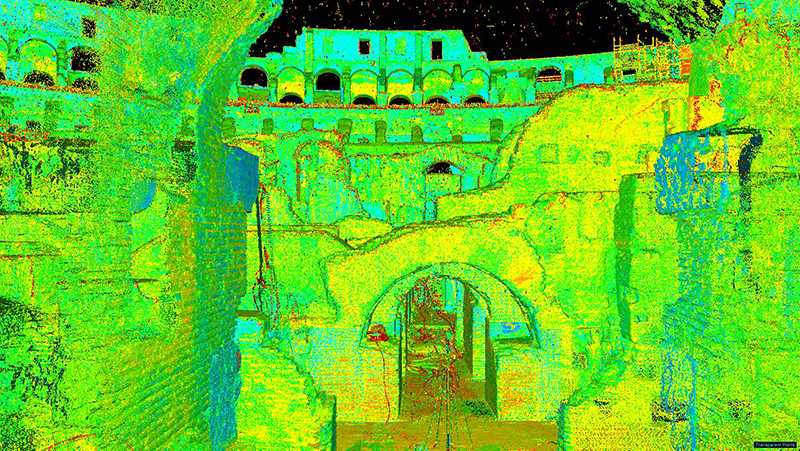
© https://ianus.co/en/portfolio/the-colosseum-rome/#iLightbox[gallery_image_1]/3
Mapping the Hypogeum: LiDAR and 3D Imaging
In 2021, archaeologists with the Parco Archeologico del Colosseo began using LiDAR (Light Detection and Ranging) and 3D scanning to create the most detailed map ever made of the hypogeum. These tools penetrate layers of decay and debris, reconstructing the original layout of elevators, trapdoors, and storage rooms. The scans show how enslaved crews operated complex machinery to hoist animals like lions and bears into the arena, creating “surprise” effects that thrilled crowds.
The Human Cost of Spectacle
William L. MacDonald, in The Architecture of the Roman Empire, Volume II: An Urban Appraisal, explores how the design of the Colosseum’s hypogeum prioritized functionality over human welfare. Its narrow passageways confined workers, animals, and combatants in tight spaces, heightening stress and danger. Structural evidence suggests the presence of temporary animal cages, while architectural details hint at the harsh conditions endured by those who labored there. MacDonald characterizes the hypogeum as a meticulously engineered yet brutal environment, where spectacle and suffering were intrinsically linked.
Engineering Marvels and Political Theater
The hypogeum wasn’t just functional – it was symbolic. The Colosseum’s advanced engineering, including hydraulic lifts and rotating platforms, showcased Rome’s technological prowess. Emperors used these spectacles to demonstrate their power: the ability to control nature (via exotic animals) and human lives (through gladiatorial combat) reinforced their authority. For a deeper dive into Roman engineering feats, explore Roman engineering and its role in imperial propaganda.
Why This Matters
The hypogeum’s secrets remind us that the Colosseum was more than a sports arena—it was a microcosm of Roman values and hierarchies. The gladiatorial games were tightly linked to social status, with elites attending as patrons and the poor viewing them as escapism. Meanwhile, the labor of enslaved people, detailed in slavery in ancient Rome, made these spectacles possible.
These findings also challenge modern perceptions of Roman “innovation.” While the hypogeum was a marvel of design, its purpose – to facilitate violence – reflects the empire’s moral complexities. For context on how architecture shaped daily life, see Roman architecture, or learn about the social classes that determined who lived, died, or cheered in the stands.
Bringing the Hypogeum to Life
To visualize these discoveries, watch National Geographic’s Colosseum: Roman Death Trap on YouTube. The documentary uses CGI to recreate the hypogeum’s operations, showing how a single day’s events required military-like precision.
As technology peels back layers of history, the Colosseum’s underground reminds us that Rome’s grandeur was built on both ingenuity and inequality – a lesson that resonates long after the crowds have vanished.
